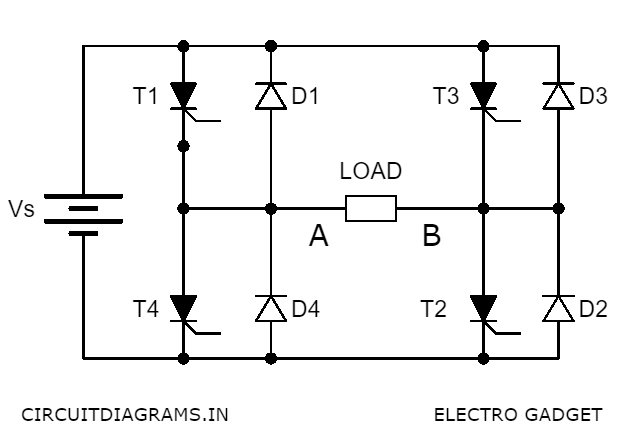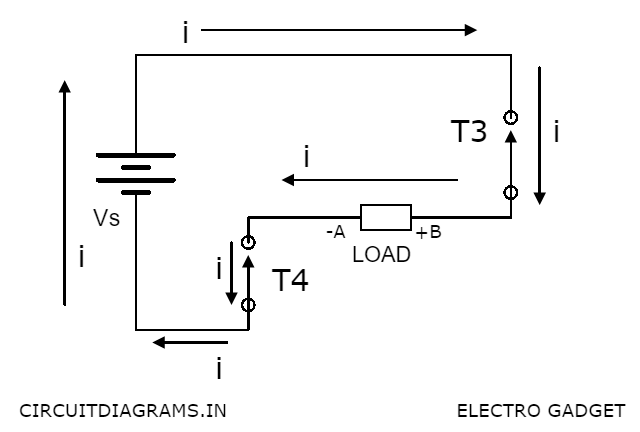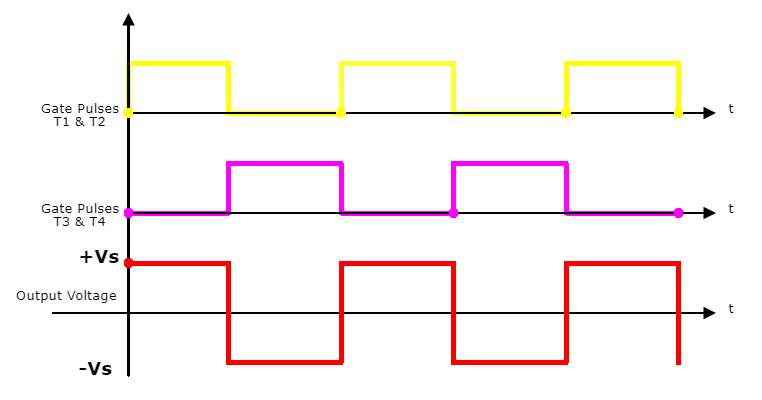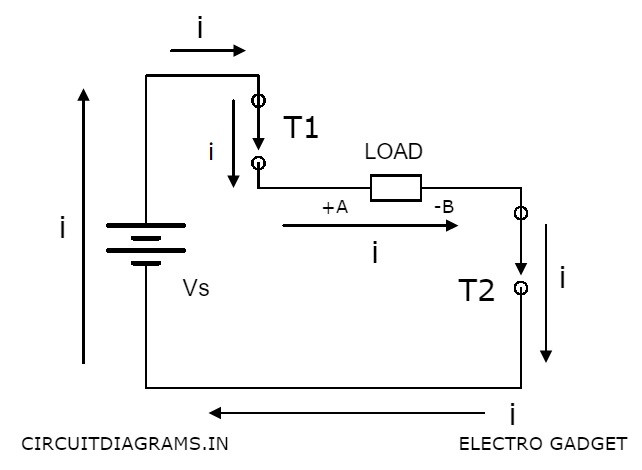Welcome to the power electronics tutorial series. In this series, we will see the working principle of power inverters. It is an electrical device that can convert a DC signal into an AC signal with respect to standard magnitude and frequency. It is also called a DC to AC Power Converter. Power inverters are two types according to the characterization that is single-phase inverters and three-phase inverters. Single-phase inverters are classified into two types, i.e. half bridge inverters and full bridge inverters.
In this session, I will be going to explain a single-phase full bridge inverter. In this single-phase full bridge inverter, I will explain the circuit working principle and waveform to complete this session regarding this full bridge inverter.
What is a Single-Phase Full Bridge Inverter?
A single-phase full bridge inverter is a switching device that generates a square wave AC voltage in the output on the application of DC voltage in the input by adjusting the switch ON and OFF. The voltage in the output of a full bridge inverter is either -VDC,+VDC or 0.
Classification of Power Inverter
According to classification, inverters are five types.
Output Characteristics
- Square Wave Inverter
- Sine Wave Inverter
- Modified Sine Wave Inverter
Source of the Inverter
- Current Source Inverter
- Voltage Source Inverter
Type of Load
Single-Phase Inverter
- Half Bridge Inverter
- Full Bridge Inverter
Three Phase Inverter
- 180-Degree Mode
- 120-Degree Mode
PWM Technique
- Simple Pulse Width Modulation
- Multiple Pulse Width Modulation
- Sinusoidal Pulse Width Modulation
- Modified Sinusoidal Pulse Width Modulation
Number of Output Levels
- Regular Two-Level Inverter
- Multi-Level Inverter
Circuit Diagram

Working Principle of Full Bridge Inverter
So this is the circuit that converts DC to AC only for a single-phase system. So if you’re having a single-phase load, you will be able to convert DC to AC by having this type of circuit. One important thing to remember while analyzing this type of circuit is the polarity of the load. So if the current is flowing from A to B the current is assumed as positive and if A is positive concerning B then the voltage is also positive. this convention is very very important because this will be very useful for us to understand the waveforms. So how to analyze this type of circuit?
Case 1: When the switches T1 and T2 are ON
The equivalent circuit of it looks like this. One important thing is always trying to draw an equivalent circuit, it will be easy for you to analyze a circuit in a very simple way. Now current starts flowing from the DC source in this particular direction since T1 and t2 are turned on T3 and T4 is not triggered, so T1 and T2 access short circuit while T3 and T4 access open circuit.
Let us assume “i” is the current flowing, so the current flows through this direction (point a 🠒 b 🠒 c 🠒 d). The output voltage will be positive A with respect to B. So consequently current will return through this direction (point d 🠒 e 🠒 f). As a whole what I’m trying to say is whatever supplied voltage is given here will directly appear across the load terminal, because this is a short circuit. If you carefully observed the supply is directly connected to the load. As a result output current is positive, because of the current convention that you assume is from A to B. It is positive, and as a result, the current is also positive.
Output voltage +VS, because this is a short circuit direct supply, which is given to the load terminal. So if you’re giving a different voltage value, whatever voltage you’re giving will directly across the load terminal.
Case 2: When the switches T3 and T4 are ON
Next, I will be assuming switches T3 and T4 are returned on, while providers T1 and T2 are turned off so the circuit looks like this.

T3 and T4 access short circuits. Current starts flowing through the supply from here ( a 🠒 b 🠒 c 🠒 d 🠒 e 🠒 f ) and returns to the source.
Now what happens is that the output current is negative because it is flowing from B to A according to our convention, it is in the opposite direction. As a result, we are taking it as negative and if you carefully observed output voltage is also negative. So as a whole, VS is supplied and that directly appears across the load terminal.
So if you carefully observed that (+) is directly connected to B, so it is positive and (-) is directly connected to A. As a result, you will be getting the output voltage to be equal to -VS.
So once we know the values of voltages and currents that will be there in the circuit, now how is the conversion of DC to AC achieved? It can be analysed through waveforms. Now let us look into the getting pulses of T1 and T2. So I’ll be triggering T1 and T2 and I’ll be turning them off for the remaining duration. T3 and T4 will be done only when T1 and T2 are turned off. The reason is very simple, if you’re turning them all together, then the entire circuit will be shorted and you’ll not be getting any of the output and there is a chance that the supply also will get damaged.
What do the output voltage and current waveform look like?

So it looks like this, when T1 and T2 are turned on and the output voltage is (+) VS. Consequently once T1 and T2 are turned off and T3 and T4 are turned on, the voltage or current will immediately change to (-) VS according to the inference that we have noted down with respect to case 2.
Again in the next cycle, when T1 and T2 are triggered, the output voltage will be equal to (+) VS. The voltage across the load will basically be the supply voltage, so it changes instantly. As a result, there will be no deviations where it increases slowly or decreases slowly. So this is for a resistive load, as a result, it will change instantly.
If we want to build an AC supply i.e. in our household applications, requires pure sinusoidal AC. So we cannot directly give the circuit to our household appliances. For this, we need to convert a square wave to a sinusoidal waveform. Doing this, we need to use filters in order to achieve that.
For mathematical working principle check this Working Principle of Full Bridge Inverter With Expressions
Advantages of Full Bridge Inverter
Important Formula
1. The conduction angle of each diode is φ.
2. The conduction angle of each Thyristor is π – φ.
3. Self-commutation is possible only in leading power factor load or underdamped system at circuit turn-off time tc = φ / w0; where w0 is the fundamental frequency.
4. Fourier series V0 (t) = ∑n=1,3,5α [ 4 VDC/ nπ ] Sin nw0t.
5. I0 (t) = ∑n=1,3,5α [ 4 VDC / nπ l zn l ] Sin nw0t + φn.
6. V01max = 4 Vdc / π.
7. I01max = 4 VDC / πZ1.
8. l zn l = R2 + ( nw0L – 1/ nw0C) ; where n = 1,2,3,4…
9. φn = tan -1 ( 1 / R ).
10. Fundamental Displacement factor FDF = cos φ.
11. Diode current equation ID and waveform is:
ID01 (avg) = 1/2π [ ∫0φ I01 max Sin ( w0t – φ1 ) ] dwt
ID01 (rms) = [ 1/2π [ ∫0φ I01 max2 Sin2 ( w0t – φ1 ) dwt ] ]1/2
12. Switch or thyristor current equation IT and waveforms is:
IT01 (avg) = 1/2π [ ∫φπ I01 max Sin ( w0t – φ1 ) ] dwt
IT01 (rms) = [ 1/2π [ ∫φπ I01 max2 Sin2 ( w0t – φ1 ) dwt ] ]1/2
Advantages of Full Bridge Inverter
- There is minimal fluctuation of voltage in the circuit.
- It is also suitable for high input voltage.
- Energy-Efficient.
- The current rating of the circuit is equal to the load current.
- It drives slightly more voltage ripples than a half-bridge inverter.
Disadvantages of Full Bridge Inverter
- The efficiency of the full bridge inverter ( 95% ) is less than the half-bridge inverter (99%).
- Losses and noise are high, so it requires more switching elements.
- It is analogous to the half-bridge inverter. However, it’s an extra segment to attach the ground point to the load.
Applications of Full Bridge Inverter
- This is used in the application of a higher voltage requirement.
- It can be applicable in low and medium power example square wave / quasi square wave voltage.
- Solar inverters can use this type of power inverter.
- It also uses in these types of devices like AC variable motors, heating induction devices, standby power supplies etc.
Difference Between Full Bridge And Half Bridge Inverter
| Parameter | Full Bridge Inverter | Half Bridge Inverter |
|---|---|---|
| The number of devices conducting simultaneously. | Two | One |
| The number of power electronics switches used. | Four | Two |
| Efficiency | Lower than half-bridge inverter (95%) | High (99%) |
| Noise | High | Lower than Full Bridge Inverter |
| The maximum value of output voltage | Peak voltage is half of the DC supply voltage | The peak voltage is the same as the DC supply voltage |
Frequently Asked Questions
A single-phase full bridge inverter is a switching device that generates a square wave AC voltage in the output on the application of DC voltage in the input by adjusting the switch ON and OFF. The voltage in the output of a full bridge inverter is either -VDC,+VDC or 0.
The voltage across the load will basically be the supply voltage, so it changes instantly. As a result, there will be no deviations where it increases slowly or decreases slowly. So this is for a resistive load, as a result, it will change instantly.
With respect to the output voltage, the difference between these two inverters is full bridge inverter is equal to the power supply voltage while the half-bridge inverter is equal to one half of the power supply voltage. According to this point, a full bridge inverter is preferred over a half-bridge inverter.

An interesting article.
I have a solar array producing 205V DC and I would like to power an electric hot water system 240V AC. Can I use a full bridge inverter to change the DC to AC ?
Could I use the Tesla coil DRSSTC SSTC full bridge inverter ?